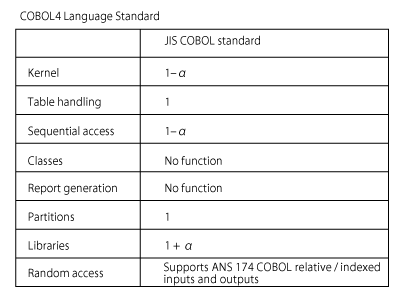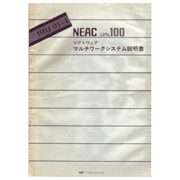NEC named its newly developed operating systems for office computers OS-3, OS-4, and OS-1. The number appended to the operating systems’ names referred to the main storage unit: 3 was for drum memory, 4 for disks, and 1 for floppy disks. The operating systems were installed and shipped on NEAC System 100G and 100H office computers, which were improved successors to the NEAC System 100, starting in August 1975.
In April 1976, NEC installed and shipped the operating systems on NEAC System 100E and 100F office computers (lower end models of the 100G and 100H), which were the first domestic machines equipped with a 16-bit LSI processor and LSI peripheral control circuitry. NEAC System 100E and 100F were standard equipped with CRT displays in place of the printers used on older models, making them the first desktop office computers in Japan. Although the CRT was small, only 40-characters wide and 16-lines tall, it offered a completely new level of operability compared to previous computers. The CRT and keyboard worked in sync, and these not only enabled entering commands to the computer and the display of messages from the computer; they replaced the conventional keyboard-printer combination for entering and displaying data in business and administration processes.
The 100E and 100F were able to run COBOL as a language to develop applications. The COBOL version was called COBOL4 and complied with the JIS Level 1 COBOL standard. Although it was a rather primitive version, having COBOL as an office computer development language was groundbreaking.

- Home >
- Historical Computers in Japan >
- Office Computer OS >
- OS-1,OS-3,OS-4
【NEC】OS-1, OS-3, and OS-4

OS-4 had three processing modes according to the program’s execution format.
- Batch processing — OS-4 was equipped with a JCL to enable sequential execution of programs.
- Enquiry processing — In this processing mode, the operating system suspended the currently executing batch program and launched and executed a higher priority program via an interrupt; when the interrupt program completed, the suspended batch program would resume.
- Multiwork processing — On multiwork systems, which began shipping in December 1977 and could connect to as many as eight stations (typewriter stations or display stations), the operating system, in this processing mode, could run up to nine tasks sequentially, with up to eight tasks, such as billing or other business processes, running in the foreground and one batch task running in the background. The operating system had an exclusive control function for file sharing, which allowed the development of programs that confirmed the latest inventory levels based on invoices and other data. The operating system also provided the functionality to share a single printer on a per-page basis between multiple programs.
NEC’s experiences with these operating systems were used in the next series of powerful office computer operating systems and were developed into the future dialog-based ITOS operating system. These systems were able to carry on the operability and user program assets from previous systems, even as functions were added and enhanced and the size of systems (such as the number of terminal connections) grew.
 | ||
| Cover of the NEC NEAC System 100 multiwork system’s manual |
All Rights Reserved, Copyright (C) Information Processing Society of Japan

